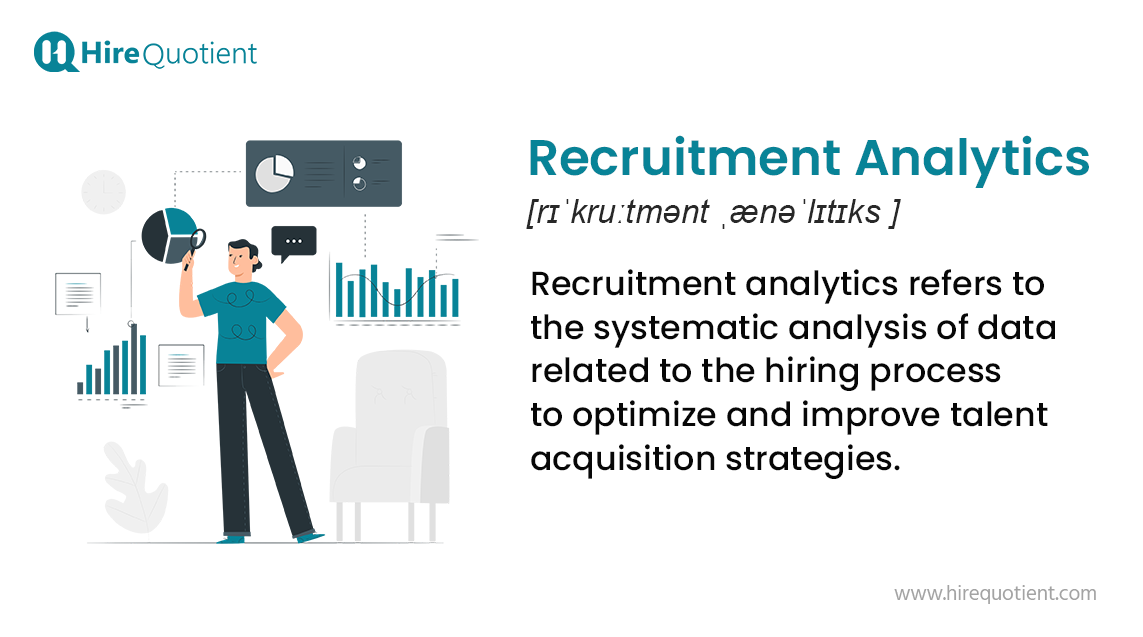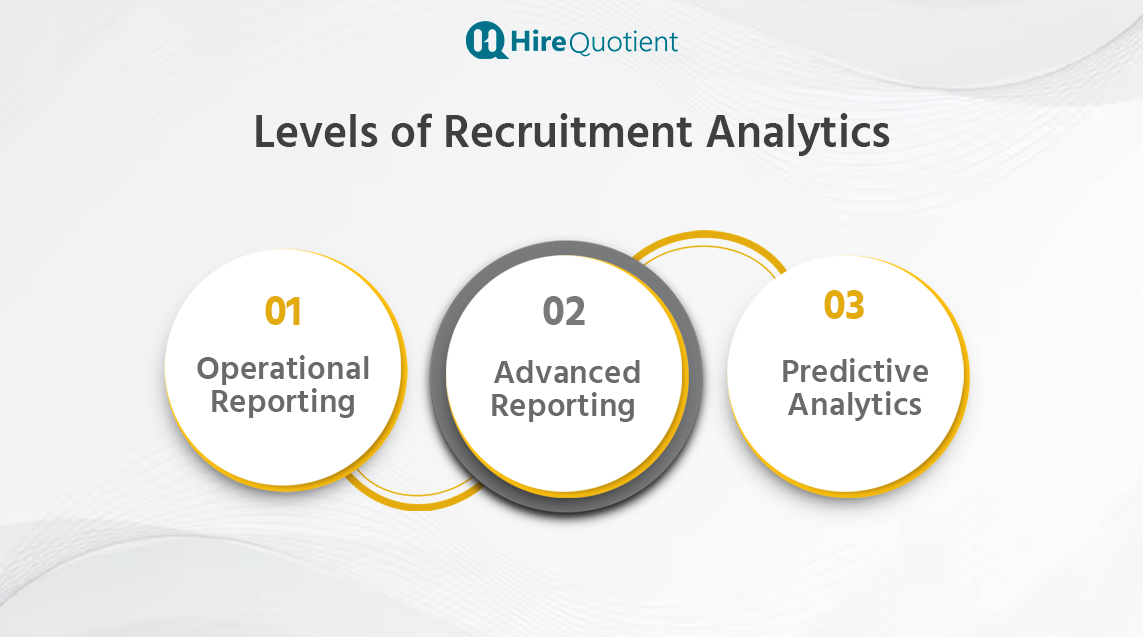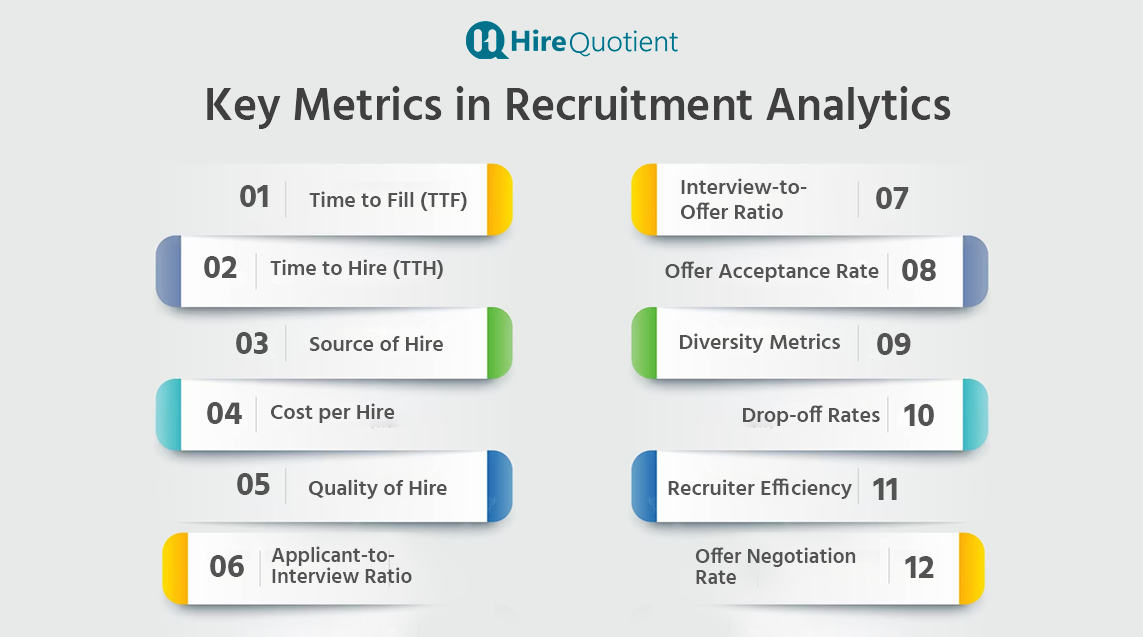Recruitment Analytics
Recruitment analytics refers to the systematic analysis of data related to the hiring process to optimize and improve talent acquisition strategies.
The Future of Recruitment is Data-Driven
Recruitment Analytics is a game-changing approach that leverages the prowess of data to revolutionize the way organizations attract, assess, and secure top-tier talent.
Recruitment Analytics isn't just about sifting through data; it's about extracting meaningful insights that guide strategic decisions. Discover how these insights shape diversity and inclusion initiatives, fuel predictive models that foresee future hiring needs, and enhance the overall quality of your workforce.
What is Recruitment Analytics? - Recruitment Analytics Meaning

Recruitment Analytics, often referred to as talent analytics or HR analytics, is the process of using data analysis and quantitative methods to gain insights into various aspects of the recruitment and talent acquisition process. It involves collecting, measuring, and analyzing data related to recruitment efforts with the goal of optimizing and improving the efficiency and effectiveness of hiring processes.
Recruitment analytics encompasses a wide range of metrics and key performance indicators (KPIs) that help HR professionals and organizations understand and enhance their recruitment strategies. These analytics enable data-driven decision-making, allowing companies to make informed choices about their hiring practices.
Importance of Data Analytics in Recruitment
Data analytics has become increasingly important in various aspects of business operations, and recruitment is no exception. Here are some key reasons why data analytics is crucial in the recruitment process:
- Informed Decision-Making: Data analytics provides recruitment professionals with insights that enable informed decision-making. By analyzing historical recruitment data, organizations can identify trends, patterns, and successful hiring strategies. This helps them make better choices when selecting candidates and designing recruitment strategies.
- Objective Candidate Evaluation: Data-driven recruitment reduces bias in candidate evaluation. Objective data points, such as skills assessments, test scores, and performance metrics, allow recruiters to assess candidates based on their actual capabilities rather than relying solely on subjective impressions.
- Efficient Screening: Data analytics streamlines the candidate screening process. By using algorithms to analyze resumes and applications, recruiters can quickly identify top candidates who possess the required skills and qualifications. This saves time and effort compared to manual screening.
- Predictive Hiring: Data analytics can help predict candidate success in a role. By analyzing past hiring data and correlating it with job performance, organizations can build predictive models that identify candidates who are likely to excel in a particular position.
- Talent Pool Management: Data analytics enables organizations to maintain a talent pool of potential candidates for future roles. By categorizing and tagging candidates based on their skills, experience, and preferences, recruiters can easily match candidates with suitable job openings when they arise.
- Optimized Job Descriptions: Data analytics can help refine job descriptions based on the preferences and expectations of successful candidates. Analyzing which keywords and phrases attract the right candidates can result in more targeted and effective job postings.
- Feedback-Driven Improvements: Through analytics, organizations can gather feedback from candidates about their recruitment experience. This feedback can highlight areas for improvement, such as communication, interview processes, and overall candidate satisfaction.
- Cost Efficiency: Effective use of data analytics can lead to cost savings in the recruitment process. By identifying the most effective sourcing channels and strategies, organizations can allocate their resources more efficiently.
- Market Insights: Data analytics provides insights into the competitive landscape, including salary trends, skill demand, and market conditions. This information helps organizations adjust their recruitment strategies to stay competitive in attracting top talent.
- Continuous Improvement: Data analytics enables continuous improvement of the recruitment process. By measuring key performance indicators (KPIs) such as time-to-fill, cost-per-hire, and candidate quality, organizations can identify bottlenecks and areas for optimization.
Benefits of Recruitment Analytics
- Improved Decision-Making: Recruitment analytics provide valuable insights into the effectiveness of different recruitment channels, sources, and methods. This enables organizations to make data-driven decisions about where to allocate resources and which strategies yield the best results.
- Enhanced Efficiency: By analyzing data related to the recruitment process, organizations can identify bottlenecks, streamline workflows, and reduce inefficiencies. This leads to a more streamlined and faster hiring process.
- Cost Savings: Understanding which recruitment sources and methods yield the highest quality hires allows organizations to focus their resources on the most effective channels. This can lead to reduced costs associated with ineffective or redundant recruitment strategies.
- Better Candidate Experience: Through analytics, organizations can gain insights into the candidate experience at various stages of the recruitment process. This information can be used to identify pain points and areas for improvement, leading to a more positive and engaging candidate journey.
- Talent Pool Management: Recruitment analytics can help organizations build and maintain a strong talent pool. By tracking and analyzing candidate data, companies can identify potential future hires and engage with them over time, reducing time-to-fill for critical positions.
- Diversity and Inclusion: Analytics can assist in monitoring diversity and inclusion efforts in the recruitment process. By measuring the representation of different demographics at various stages, organizations can identify potential biases and take corrective actions to ensure fairness and equity.
- Predictive Analysis: Advanced recruitment analytics can leverage historical data to predict future hiring needs. This helps organizations plan ahead, ensuring they have the right talent in place to meet business demands.
- Continuous Improvement: Data-driven insights allow organizations to continuously monitor and improve their recruitment strategies. By analyzing key performance indicators (KPIs) over time, they can refine their approaches and stay ahead of industry trends.
- Alignment with Business Goals: Recruitment analytics help organizations align their hiring efforts with broader business goals. By understanding the types of candidates that contribute most to organizational success, companies can tailor their recruitment strategies accordingly.
- Measurement of Recruitment ROI: Recruitment analytics allow organizations to measure the return on investment (ROI) of their recruitment efforts. This includes calculating the cost per hire, time-to-fill, and other metrics that provide a clear picture of the value generated by the recruitment process.
- Customization of Strategies: Different roles and positions require different recruitment strategies. Analytics provide insights into which strategies work best for specific job types, enabling organizations to customize their approach for each hiring need.
- Compliance and Regulation: Analytics can help organizations ensure compliance with legal and regulatory requirements in the hiring process. By tracking relevant data points, companies can demonstrate fairness and adherence to regulations.
Levels of Recruitment Analytics

There are three levels of recruitment analytics:
- Operational reporting is the most basic level of recruitment analytics. It involves collecting and summarizing data on key metrics, such as the number of applicants, the time to fill a position, and the cost of hiring. This data can be used to track the performance of the recruitment process and identify areas for improvement.
- Advanced reporting takes operational reporting a step further by analyzing the data to identify trends and patterns. This can help to identify the most effective recruiting channels, the best time to post jobs, and the ideal candidate profile.
- Predictive analytics is the most advanced level of recruitment analytics. It uses data to build models that can predict future outcomes, such as which candidates are most likely to be successful in a role. This information can be used to improve the decision-making process and make better hiring decisions.
Key Metrics in Recruitment Analytics

Recruitment analytics involves using data and metrics to optimize various aspects of the recruitment process. These metrics help organizations make informed decisions and improve their overall hiring strategy. Here are some key metrics in recruitment analytics:
- Time to Fill (TTF): This metric measures the number of days it takes to fill a job vacancy from the time it's posted. A shorter time to fill indicates an efficient and streamlined recruitment process.
- Time to Hire (TTH): Similar to time to fill, time to hire measures the number of days from the initial job application to the candidate's acceptance of the offer. It encompasses the entire hiring process.
- Source of Hire: This metric tracks where candidates are coming from, such as job boards, social media, employee referrals, etc. Understanding the most effective sources helps allocate recruitment resources more effectively.
- Cost per Hire: This metric calculates the average cost of filling a position, including expenses related to advertising, agency fees, background checks, and more. It helps in evaluating the cost-effectiveness of various recruitment methods.
- Quality of Hire: Measuring the performance and tenure of candidates hired can provide insights into the effectiveness of the recruitment process. It helps assess whether the right candidates are being selected.
- Applicant-to-Interview Ratio: This metric shows the number of applicants who are selected for interviews compared to the total number of applicants. A high ratio might indicate an effective screening process.
- Interview-to-Offer Ratio: This metric reflects the number of candidates who receive job offers after the interview stage. A low ratio could indicate issues with candidate alignment or compensation.
- Offer Acceptance Rate: This metric measures the percentage of job offers that candidates accept. A low acceptance rate could signal problems with the offer package, company reputation, or candidate experience.
- Diversity Metrics: Tracking diversity-related metrics such as the percentage of diverse candidates in the pipeline, interview-to-hire ratio for different groups, and retention rates can help monitor progress toward diversity and inclusion goals.
- Drop-off Rates: Monitoring the stages where candidates drop out of the application process can identify pain points and bottlenecks that need addressing.
- Recruiter Efficiency: Metrics such as the number of requisitions managed per recruiter, time spent on administrative tasks, and time spent on strategic recruiting activities help evaluate recruiter efficiency.
- Offer Negotiation Rate: This metric indicates how often candidates negotiate their job offers. It can provide insights into whether the initial offers are competitive.
Predictive Analytics in Recruitment
Predictive analytics in recruitment involves using data and statistical algorithms to make predictions about future hiring outcomes. By analyzing historical data and identifying patterns, organizations can make more informed decisions throughout the recruitment process.
How to get started with predictive analytics in recruitment?
Here are some steps on how to get started with predictive analytics in recruitment:
- Define your goals. What do you want to achieve by using predictive analytics in recruitment? Do you want to improve your time to fill, reduce your cost per hire, or improve the quality of your hires?
- Collect the right data. The data that you collect must be relevant to your goals. For example, if you want to improve your time to fill, you will need to collect data on the time it takes to fill open positions.
- Choose the right predictive analytics tool. There are many different recruitment analytics software available. Choose a tool that is right for your needs and budget.
- Build your model. Once you have chosen a recruitment analytics tool, you will need to build your model. This involves selecting the right variables and algorithms for your model.
- Test your model. Once you have built your model, you will need to test it to make sure that it is accurate. You can do this by testing it on historical data.
- Deploy your model. Once you are confident that your model is accurate, you can deploy it to production. This means using the model to make predictions about future hiring activities and candidates.
- Monitor and improve your model. Once your model is deployed, you will need to monitor its performance and make improvements as needed. This is important to ensure that the model continues to be accurate.
Recruitment Analytics Best Practices
Here are some best practices for using recruitment analytics:
- Define clear analysis goals. What do you want to achieve by using recruitment analytics? Do you want to improve the time to hire, reduce costs, or increase the quality of hire? Once you know your goals, you can start to identify the right metrics to track.
- Collect relevant data. Not all data is created equal. When collecting data for recruitment analytics, it's important to focus on the metrics that are most relevant to your goals. For example, if you're trying to improve the time to hire, you'll want to track metrics like the number of days it takes to fill a position and the number of candidates interviewed per hire.
- Visualize your data. Once you have collected your data, it's important to visualize it in a way that makes sense. This will help you to identify trends and patterns that might not be obvious from looking at the raw data. There are a number of different ways to visualize data, so choose a method that works best for you and your team.
- Put the data into perspective. Data doesn't tell the whole story. It's important to put the data into perspective by considering other factors, such as the industry you're in, the size of your company, and the budget you have available.
- Optimize your hiring process with data insights. Once you've identified areas for improvement, you can use the data to optimize your hiring process. This might involve changing your sourcing methods, improving your interview process, or providing more training to your recruiters.
- Use the data to plan for the future. The data can also be used to plan for the future. For example, you can use it to forecast your hiring needs or to identify skills gaps in your workforce.
- Recognize data limitations. No data set is perfect. It's important to recognize the limitations of your data and to take steps to mitigate them. For example, if you're using self-reported data, you'll need to be aware that it may not be accurate.
Challenges in Recruitment Analytics
There are a number of challenges associated with recruitment analytics, including:
- Data quality: The quality of the data used for recruitment analytics is critical. If the data is inaccurate, incomplete, or outdated, the insights generated will be unreliable.
- Data silos: Often, data related to recruitment is siloed in different systems and databases. This makes it difficult to collect and analyze all of the data that is relevant to the recruitment process.
- Lack of skills and expertise: Recruitment analytics requires a certain level of skills and expertise in data science and analytics. Not all organizations have the resources to develop these skills in-house.
- Resistance to change: Some people may be resistant to change, and may be reluctant to adopt new technologies or processes. This can be a challenge when implementing recruitment analytics.
- Cost: Recruitment analytics can be a costly investment, especially for small or medium-sized businesses.
Final Note
In conclusion, the realm of recruitment analytics offers an invaluable opportunity for organizations to revolutionize their hiring processes and make data-driven decisions that lead to better outcomes. By harnessing the power of data and technology, businesses can gain insights into every stage of the recruitment journey, from candidate sourcing and screening to onboarding and retention.